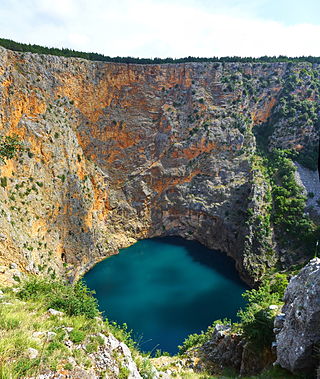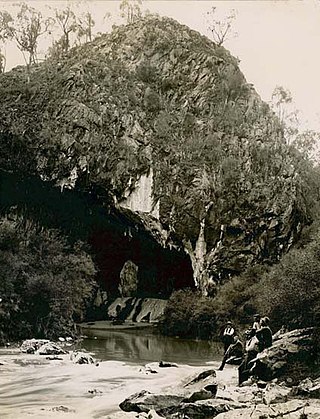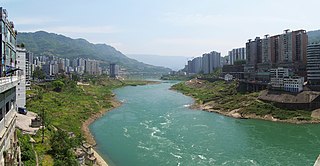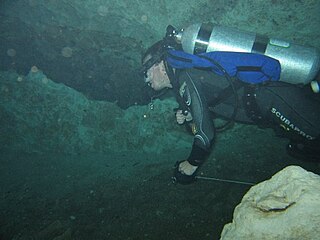San Wang Dong is a large karst cave in the Wulong Karst formation region, located within Wulong County of Chongqing Municipality in China.
The current known combined length of its passages is 67,825 metres (222,523 ft) long. [1] San Wang Dong has numerous large cave rooms and passages, many of which are almost intact. [1]
San Wang Dong cave lies close to another huge Wulong Karst cave named Er Wang Dong. San Wang Dong is located lower than Er Wang Dong, and both caves might be connected.
San Wang Dong was known to local people, although its exploration only began around a decade ago. The first major scientific exploration of the cave was organized by the international Hong Meigui Cave Exploration Society. [1]

Chongqing is a direct-administered municipality in Southwestern China. Chongqing is one of the four direct-administered municipalities under the Central People's Government, along with Beijing, Shanghai, and Tianjin. It is the only directly administrated municipality located deep inland. The municipality covers a large geographical area roughly the size of Austria, which includes several disjunct urban areas in addition to Chongqing proper. Due to its classification, the municipality of Chongqing is the largest city proper in the world by population, though Chongqing is not the most populous urban area.

A sinkhole is a depression or hole in the ground caused by some form of collapse of the surface layer. The term is sometimes used to refer to doline, enclosed depressions that are also known as shakeholes, and to openings where surface water enters into underground passages known as ponor, swallow hole or swallet. A cenote is a type of sinkhole that exposes groundwater underneath. Sink, and stream sink are more general terms for sites that drain surface water, possibly by infiltration into sediment or crumbled rock.

Actun Tunichil Muknal, also known locally as ATM, is a cave in Belize, near San Ignacio, Cayo District, notable as a Maya archaeological site that includes skeletons, ceramics, and stoneware. There are several areas with skeletal remains in the main chamber. The best known is "The Crystal Maiden", the skeleton of what is believed to be a 17-year-old boy, possibly a sacrifice victim, whose bones have been calcified to a sparkling, crystallized appearance.

A blue hole is a large marine cavern or sinkhole, which is open to the surface and has developed in a bank or island composed of a carbonate bedrock. Blue holes typically contain tidally influenced water of fresh, marine, or mixed chemistry. They extend below sea level for most of their depth and may provide access to submerged cave passages. Well-known examples are the Dragon Hole and, in the Caribbean, the Great Blue Hole and Dean's Blue Hole.

The Abercrombie Caves, contained within the Abercrombie Karst Conservation Reserve, are a series of limestone arch caves that are located in the Central West region of New South Wales, Australia. The caves are renowned for their karst qualities, namely the formation that has been eroded by water action that has developed from a sinkhole to become a blind valley. Several good examples of crayback formations exist in both entrances.

Wulong District is a district of Chongqing Municipality, China, bordering Guizhou province to the south.

The South China Karst, a UNESCO World Heritage Site since June 2007, spans the provinces of Chongqing, Guangxi, Guizhou, and Yunnan. It is noted for its karst features and landscapes as well as rich biodiversity. The site comprises seven clusters Phase I: Libo Karst, Shilin Karst, and Wulong Karst inscribed in 2007, and Phase II: Guilin Karst, Shibing Karst, Jinfoshan Karst, and Huanjiang Karst inscribed in 2014. UNESCO describes the South China Karst as "unrivalled in terms of the diversity of its karst features and landscapes".
Houping Miao and Tujia Ethnic Township (后坪苗族土家族乡) is an ethnic township in Wulong District of the Chongqing Municipality of China The area is noted for its landscape and geological features known as the Wulong Karst and the Er Wang Dong cave.

Deer Cave, located near Miri, Sarawak, Malaysia, is a show cave attraction of Gunung Mulu National Park. It was surveyed in 1961 by G. E. Wilford of the British Borneo Geological Survey, who predicted that Mulu would yield many more caves in the future. The cave, which is also known as Gua Payau or Gua Rusa by the local Penan and Berawan people, is said to have received its name because of the deer that go there to lick salt-bearing rocks and shelter themselves.
The Pengshui Dam is an arch dam on the Wu River in Wulong County, Chongqing, China. The dam provides water to a 1,750 MW hydroelectric power station containing 5 x 350 MW generators. Construction on the dam began in September 2003 and the power plant was operational in 2008.

Furong Cave is a karst cave located on the banks of the Furong River, 20 km (12 mi) from the seat of Wulong District, Chongqing, People's Republic of China.

The Three Natural Bridges are a series of natural limestone bridges located in Xiannüshan Town, Wulong District, Chongqing Municipality, China. They lie within the Wulong Karst National Geology Park, itself a part of the South China Karst-Wulong Karst UNESCO World Heritage Site. In Chinese, the bridges are all named after dragons, namely Tianlong Qinglong and Heilong.
The Wulong Karst is a karst landscape located within the borders of Wulong District, Chongqing Municipality, People's Republic of China. It is divided into three areas containing the Three Natural Bridges, the Qingkou Tiankeng (箐口天坑) and Furong Cave respectively. It is a part of the Wulong Karst National Geology Park as well as part of the South China Karst, a UNESCO World Heritage Site.
Er Wang Dong is a large cave in the Wulong Karst region, in Wulong County of Chongqing Municipality of China.
Chongqing Xiannvshan Airport or Chongqing Xiannüshan Airport is an airport that serves Wulong, Chongqing municipality, China. The airport is located in the town of Xiannüshan (仙女山), also spelled as Xiannyushan or Xiannvshan, 20 kilometres (12 mi) north of the urban center of Wulong District, it is expected to mainly serve tourists visiting the Wulong Karst landscape, a UNESCO World Heritage Site. Construction began in 2014 and lasted five years, with an estimated total cost of 1.333 billion yuan.

Charles William (Bill) Steele, Jr. is a cave explorer and speleologist who has led and participated in expeditions to many of the longest and deepest caves in the USA, Mexico, and China. He has explored hundreds of caves across North America and Asia and has written two books chronicling his expeditions: Yochib: The River Cave, and Huautla: Thirty Years in One of the World's Deepest Caves. TV shows such as National Geographic Explorer, NOVA and How’d They Do That? have aired programs on his expeditions.

Ojo Guareña is a karst complex located in the Cantabrian Mountains of Castile and Leon, Spain, declared a natural monument by the government of Castile and Leon in 1996. It is composed of over 90 kilometres (56 mi) of galleries and passages within an area of some 13,850 hectares. The limestone formation containing the system is approximately 100 metres (330 ft) thick and sits on a massive water-resistant layer of marl. The caves were formed in the limestone by erosion sometime within the Coniacian Age. Ojo Guareña was considered the greatest karst system of the Iberian Peninsula until 2009, when a significant length of new passages was discovered in the Mortillano system. It is also the 24th longest cave system.

Cave diving is underwater diving in water-filled caves. The equipment used varies depending on the circumstances, and ranges from breath hold to surface supplied, but almost all cave diving is done using scuba equipment, often in specialised configurations with redundancies such as sidemount or backmounted twinset. Recreational cave diving is generally considered to be a type of technical diving due to the lack of a free surface during large parts of the dive, and often involves planned decompression stops. A distinction is made by recreational diver training agencies between cave diving and cavern diving, where cavern diving is deemed to be diving in those parts of a cave where the exit to open water can be seen by natural light. An arbitrary distance limit to the open water surface may also be specified. Despite the risks, water-filled caves attract scuba divers, cavers, and speleologists due to their often unexplored nature, and present divers with a technical diving challenge.